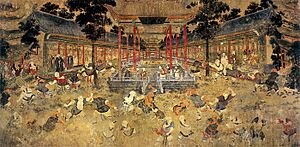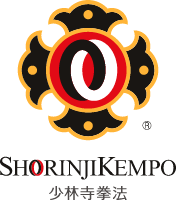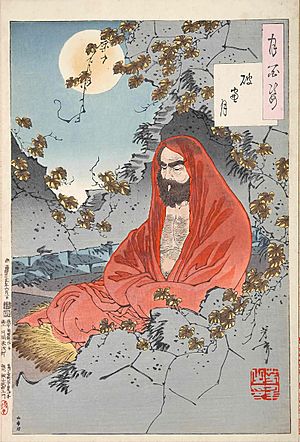Shorinji Kempo facts for kids
 |
|
|---|---|
| Also known as | • Nippon Shorinji Kempo • Shōrinji Kempō |
| Focus | Hybrid |
| Hardness | Both hard and soft |
| Country of origin | |
| Creator | Doshin So |
| Famous practitioners | Yuki Kondo, Sonny Chiba, Etsuko Shiomi, Hiroyuki Sanada, Norio Wakamoto, Tak Sakaguchi, Kengo Ohkuchi, Keisuke Itagaki, Masaya Tokuhiro, Yoshisada Yonezuka, Shinobu Ichiyanagi, Kenneth Kimmins, Nao Nagasawa, Koji, Toma Kuroda |
| Parenthood | Shaolin kung fu, Hakko-ryu jujutsu, Fusen-ryū jūjutsu |
| Descendant arts | Byakuren Kaikan |
| Olympic sport | No |
| Official website | World Shorinji Kempo Organisation(WSKO) Shorinji Kempo Unity |
Shorinji Kempo (少林寺拳法, Shōrin-ji Kenpō) is a Japanese martial art. Its name means "Shaolin Temple Pugilism." It was created in 1947 by Doshin So (宗 道臣, Sō Dōshin), whose birth name was Michiomi Nakano. He was a Japanese martial artist and a former spy who lived in China for many years.
Shorinji Kempo is a complete system that trains your whole self. It has three main parts:
- Self-defense training
- Mental training
- Health training
The main ideas are that your "spirit and body are not separable" (心身一如: shinshin-ichinyo) and that you should train "body and mind as one" (拳禅一如: kenzen ichinyo).
Shorinji Kempo helps people become stronger and more confident. It also teaches them to help others. The ideas and moves of Shorinji Kempo are written in their main book, Shōrinji-Kempō-kyōhan.
Contents
What is Shorinji Kempo?
Shorinji Kempo is both a true budō (martial way) and a system for learning. It is known for its mental training and its physical training places, called dōjō.
The founder, Doshin So, wanted to create a system that trained both mind and body. He also wanted to help Japanese people who felt lost after World War II. His goal was to help them rebuild their lives and Japan. He tried teaching Buddhist philosophy, but people weren't interested. Later, he was inspired by a vision of Bodhidharma, who was believed to have taught martial arts. This led Doshin So to combine martial arts with Buddhist ideas.
Shorinji Kempo includes many self-defense moves called hokei (法形). For shows or competitions, these moves are put together into a planned routine called an embu (演武). An embu usually has 6 parts. Each part includes gōhō (剛法), which are hard techniques, and jūhō (柔法), which are soft techniques.
In a pair embu, one person attacks and the other defends for one part. Then, they switch roles for the next part. The way techniques are used in an embu is called hien (飛燕), meaning "flying swallow." This shows how fast and smooth the moves are. Sometimes, a black robe called hōi (法衣) is worn during an embu at special events.
Main Headquarters
The main headquarters of Shorinji Kempo is in Tadotsu town, Kagawa Prefecture, on Shikoku island in Japan.
The buildings there include:
- Hondo (main training hall)
- Kodo (lecture hall)
- Rensei-dojo (an older training hall)
- Shokudo (dining room)
- Daigan-toh (a memorial tower)
- Zenrin Gakuen (a college building)
The remains of Doshin So are buried behind the lecture hall.
How Shorinji Kempo is Organized
The Shorinji Kempo group is made up of five main parts:
- Religious part: Kongō-zen Sōhon-zan Shōrinji
- Foundation part: Shorinji Kempo Foundation Federation
- Education part: Zenrin Gakuen College
- Global part: World Shorinji Kempo Organization (WSKO)
- Intellectual property part: SHORINJI KEMPO UNITY
These parts work closely together because Shorinji Kempo combines religion, martial arts, and education.
National Groups
Many countries have their own Shorinji Kempo groups, including:
- Japan
- Indonesia
- Malaysia
- Switzerland
- Finland
- Sweden
- Italy
- France
- Germany
- Spain
- Portugal
- Russia
- Ukraine
- United Kingdom
- United States
- Canada
- Brazil
The Shaolin Temple Connection
The name "Shōrinji" comes from the Chinese "Shaolin Temple" in Henan Province, China. Doshin So said he learned a martial art style called Giwamon-ken (Yihe Mén Quán) from there. This style was believed to have been used during the Boxer Rebellion around 1900.
Doshin So was very impressed by paintings he saw on a wall in the Byakue-den chapel at Shaolin Temple. He felt the way the monks practiced martial arts looked very strong and alive. He believed this was where many Chinese martial arts began.
Shorinji Kempo Emblem
The swastika, called manji in Japanese, was the original symbol for Shorinji Kempo. This symbol has been used for centuries in many cultures and religions, like Buddhism. It can mean love (left-facing) and strength (right-facing).
However, because of the negative meaning the swastika gained, the World Shorinji Kempo Organization (WSKO) changed its symbol. They replaced it with the Japanese character 拳 (ken), which means "fist," inside a shield-like swastika, or used a rounded swastika.
In 2005, the Shorinji Kempo Group introduced a new symbol for all international groups. This new symbol is called so-en (double circle). It is said to be like two swastikas twisted together. The so-en emblem is now on training uniforms (keikogi), belts (obi), and the black robes (hōi) worn by high-ranking students during shows.
History of Shorinji Kempo
Doshin So, whose birth name was Michiomi Nakano, grew up in Okayama Prefecture, Japan. He spent his younger years in northern China. He lived there with his grandfather and later worked as a spy for the Japanese army during the war. To hide his true work, he pretended to be a student at a Taoist school.
There, he met Chen Liang, a Taoist priest and master of a martial art called Báilián Quán (White Lotus Fist). Chen later introduced Doshin So to Wen Taizong, a master of Yihe Quán (Righteous Harmony Fist). Wen taught Doshin So at the Shaolin Temple in Henan and passed on his knowledge of this martial art style.
Towards the end of World War II, the Soviet Union attacked Japan in Manchuria. Many Japanese people suffered greatly. Doshin So saw this terrible situation and realized how important a person's character is. He believed that good people are needed to make good societies, laws, and daily life.
After returning to Japan, Doshin So wanted to open a school for young people. He settled in Tadotsu, on Shikoku island, to teach Buddhist ideas. He created Shorinji Kempo to combine the idea of "body and mind as one" with the martial arts techniques he learned in China.
This effort to spread Shorinji Kempo was called the Kongō-zen undō (Diamond-zen campaign). His students helped it grow across Japan. After Doshin So passed away in 1980, his daughter, Yūki Sō (宗 由貴, Sō Yūki), continued his work until 2020. Doshin So is now called "Kaiso," meaning "founder."
Important Dates
- 1947: The religious part of Shorinji Kempo was started.
- 1948: The Nippon Hokuha Shorinji Kempo Society was created.
- 1951: Kongō Zen Sōhonzan Shōrinji and Kōmanji kyōdan were established.
- 1956: The educational part, Nihon Shōrinji Bugei Senmon-gakkō, was started.
- 1957: The "All Japan Shorinji Kempo Federation" was formed.
- 1963: The "Shorinji Kempo Federation of Japan" became a formal organization.
- 1972: The "International Shorinji Kempo Federation" (ISKF) was established.
- 1974: The "World Shorinji Kempo Organization" (WSKO) was established.
- 1980: Doshin So passed away.
- 1992: The "Shorinji Kempo Federation Foundation" was formed.
- 1997: Shorinji Kempo celebrated its 50th anniversary.
- 2000: The Shorinji Kempo Group was organized.
- 2002: Busen (Shorinji Kempo Budo Academy) High School opened.
- 2003: Busen was renamed Zenrin Gakuen College.
- 2003: The new so-en logo for Shorinji Kempo was designed.
- 2005: The so-en emblem was officially adopted.
- 2007: Shorinji Kempo celebrated its 60th anniversary.
- 2008: The All Japan Junior High School Shorinji Kempo Federation was formed.
- 2009: A global convention (Sekai-taikai) was held.
- 2012: Doshin So's 100th Birthday Memorial Taikai was held in Yokohama, Japan.
- 2013: The Shorinji Kempo World Taikai 2013 was held in Osaka, Japan.
- 2017: The Shorinji Kempo World Taikai was held in California, along with the 70th anniversary celebration.
Shorinji Kempo Philosophy
Shorinji Kempo is not just a traditional martial art or a sport. For its students, it is seen as a religious practice (gyō).
Buddhist teachings say that the spirit and body are connected. By practicing Shorinji Kempo moves and learning its ideas, students aim to develop a strong body and a determined spirit, like the powerful Vajradhara (金剛神: Kongō-shin) and the never-give-up spirit of Bodhidharma (菩提達磨: Bodai-daruma).
Zen and Techniques
Shorinji Kempo uses zen for mental training. Its techniques are mainly divided into three groups:
- Gōhō (剛法): These are "hard techniques" like punches, kicks, and blocks.
- Jūhō (柔法): These are "soft techniques" like throws, pins, and joint locks.
- Seihō (整法): These are "healing techniques" like acupressure and bone setting.
Doshin So wrote in his book, "What is Shorinji Kempo?", that he was inspired by the fighting techniques of Bodhidharma, known as the Arakan no ken (阿羅漢之拳) or the Arhat fist. He believed these techniques came from India thousands of years ago. He was inspired by pictures he saw on the walls of the Shaolin Temple in China.
People who practice Shorinji Kempo are called kenshi (拳士), meaning 'boxers'. Kenshi always greet each other with gassho (合掌). This is a common greeting among Buddhist students. The gassho-rei (合掌礼) is also a stance called gassho-gamae (合掌構), where both palms are pressed together in front of the face.
Ranks and Qualifications
To move up in Shorinji Kempo, students earn different ranks. These ranks show their progress in both physical and mental training. There are three main types of ranks: bukai (martial rank), hōkai (philosophical rank), and sōkai (priesthood rank).
Here are some examples of bukai (martial ranks) and their matching hōkai (philosophical ranks):
- 1st dan (初段 sho-dan) - Jun-kenshi
- 2nd dan (弐段 ni-dan) - Sho-kenshi
- 3rd dan (参段 san-dan) - Chu-kenshi
- 4th dan (四段 yon-dan) - Sei-kenshi
- 5th dan (五段 go-dan) - Dai-kenshi
For the first three dan ranks, kenshi automatically get the matching hokai if they train at a doin. If they train at a branch, they get these hokai after training at the Shorinji Kempo headquarters in Tadotsu, Japan.
Exams for 1st to 3rd dan are held at local Shorinji Kempo headquarters. However, for 4th dan and higher, special exams are only held at the main headquarters in Tadotsu.
Outside Japan, 3rd dan practitioners are often considered teachers. In Japan, 4th dan and above are teachers, but those with 5th dan and higher are officially called sensei (先生), meaning "teacher."
Arm emblems show different categories and titles:
- Category Colors:
* Red: for doin kenshi (students at main training centers) * Blue: for shibu kenshi (students at branches) * Green: for Zenrin Gakuen College kenshi * Purple: for WSKO kenshi (international students)
- Title Colors:
* Gold: for masters of a doin or shibu * Silver: for masters of a doin or shibu with 4th dan or lower * Red: for assistant masters with 3rd dan or higher
There is also a sokai (priesthood rank) for the Kongo Zen Sohon-zan Shorinji group. To get this, a 2nd dan or Sho-kenshi student studies Kongo Zen philosophy and submits an application and essay.
Training System
Shorinji Kempo training covers three main areas:
Spiritual Training
- kiryoku (気力) - inner strength
- kisei (気勢) - spirit and energy
- kiai (気合) - a powerful shout
Mental Training
- inyō (陰陽) - understanding opposites
- kyojitsu (虚実) - understanding truth and illusion
- tempō (天方) - understanding natural laws
- chii (地位) - understanding position
- chijutsu (知術) - understanding techniques
- chiryaku (知略) - understanding strategy
Physical Training
- Gō-hō (剛法) ("hard methods"): These include 8 types of techniques and 3 traditional weapon styles.
- 8 Gō-hō techniques:
* tsuki-waza (突技) - thrusting techniques * uchi-waza (打技) - striking techniques * kiri-waza (切技) - cutting techniques * keri-waza (蹴技) - kicking techniques * kari-waza (刈技) - reaping techniques * fumi-waza (踏技) - stomping techniques * taigi (体技) - body techniques * bōgi (防技) - blocking techniques
-
- 3 Gō-hō traditional weapons:
* dokko-den (独鈷伝) * nyoi-den (如意伝) * kongō-den (金剛伝)
- Jū-hō (柔法) ("soft methods"): These include 10 types of techniques.
- 10 Jū-hō techniques:
* gyaku-waza (逆技) - joint locking techniques * nage-waza (投技) - throwing techniques * katame-waza (固技) - pinning techniques * shime-waza (締技) - choking techniques * hogi (捕技) - catching techniques * ōatsugi (押圧技) - pressing techniques * nukite-hō (抜手法) - escaping hand techniques * nukimi-hō (抜身法) - escaping body techniques * shu-hō (守法) - guarding techniques * baku-hō (縛法) - tying techniques
- Sei-hō (整法) ("healing methods"):
* seikei (整経) - meridian adjustment * seimyaku (整脉) - pulse adjustment * seikotsu (整骨) - bone setting * kappō (活法) - resuscitation techniques
- Taigamae (体構え) ("stance"): These are different body positions.
- Byakuren hachi-jin (白蓮八陣) ("8 stances of Byakuren"):
* gasshō-gamae (合掌構え) * manji-gamae (まんじ構え) * midare-gamae (乱れ構え) * hassō-gamae (八相構え) * taiki-gamae (待気構え) * gyaku taiki-gamae (逆待気構え) * aiki-gamae (合気構え) * byakuren chudan-gamae (白蓮中段構え) (also called kaisoku chudan-gamae)
-
- Giwa kyū-jin (義和九陣) ("9 stances of Giwa"):
* kesshu-gamae (結手構え) * ichiji-gamae (一字構え) * niō-gamae (仁王構え) * chūdan-gamae (中段構え) * gedan-gamae (下段構え) * gyaku gedan-gamae (逆下段構え) * fukko-gamae (伏虎構え) * tate musō-gamae (立無相構え) * yoko musō-gamae (横無相構え)
- Fujin-hō (布陣法) ("body positions"): How two kenshi stand relative to each other.
* seitai-gamae (正対構え) - both kenshi face each other in the same stance. * tai-gamae (対構え) - both kenshi take the same side stance (e.g., both left-front). * hiraki-gamae (開構え) - kenshi take opposite side stances (e.g., one left-front, one right-front).
- Umpo-hō (運歩法) ("footwork"): Different ways to move your feet.
* fumikomi-ashi (踏込足) - stepping in * maeyose-ashi (前寄足) - front gathering step * kumo-ashi (蜘蛛足) - spider step * kani-ashi (蟹足) - crab step * chidori-ashi (千鳥足) - zigzag step * sashikomi-ashi (差込足) - inserting step * sashikae-ashi (差替足) - changing step * tobikomi-ashi (跳込足) - jumping in
- Tai-sabaki (体捌き) ("body movement"): Ways to move your body to avoid attacks.
* furi-mi (振身) - swinging body * sori-mi (反り身) - leaning back * hiki-mi (引身) - pulling back * ryūsui (流水) - flowing water * han-tenshin (半転身) - half turn * gyaku-tenshin (逆転身) - reverse half turn * han-tenkan (半転換) - half change * zen-tenkan (全転換) - full change
- Ukemi (受身) ("breakfalls"): Ways to fall safely.
* mae-ukemi (前受身) - front breakfall * ushiro-ukemi (後受身) - back breakfall * ōten yori okiagari (横転より起き上がり) - rolling up (also called tombo-gaeri) * dai-sharin (大車輪) - big wheel
Embu Performances
An Embu is a planned routine of Shorinji Kempo techniques. It combines goho (hard) and juho (soft) moves into 6 sections. It's like a "kata" in other martial arts, but two or more people perform it together.
Embu are performed in gyms, at competitions (Taikai), or other special events. In these routines, one kenshi acts as the attacker (kōsha 攻者), and the other acts as the defender (shusha 守者). They then switch roles and repeat the moves.
After the planned techniques, the kenshi perform ren-han-ko (連反攻). This is a series of free-form counter-attacks that continues until the original attacker successfully blocks and counters. The juho techniques are followed by katame (pinning techniques) or kime (finishing techniques that target nerve points).
Embu always start with gassho-rei (the Buddhist greeting). They are usually performed in pairs (kumi embu), by a single person (tandoku embu), or by a group of 6 or 8 people (dantai embu).
Today, embu are judged by several people. Each judge gives points for the different sections and other factors. Pair and group embu are performed within a time limit of 1.5 to 2 minutes.
Unyo-ho (Sparring)
In the past, Shorinji Kempo had a fighting competition called Unyo-ho. To make it safer, rules were added. Now, students must wear headgear, body protectors, and groin guards during sparring. Also, a system was introduced where each kenshi takes on only one role, either attacker or defender, for safety. Judges score based on attacking points, defensive techniques, and counter-attacks.
Current Status
As of 2025, Kouma So is the president of the World Shorinji Kempo Organization (WSKO). He is the son of Yuuki So and the grandson of Kaiso Doshin So, the founder. He took over from his mother in 2020, after she served for 40 years. Kazuhiro Kawashima is the national president of the Japanese Shorinji Kempo Federation.
In 2010, the British Shorinji Kempo Federation (BSKF) separated from the WSKO. However, the United Kingdom Shorinji Kempo Federation (UKSKF) is still connected to the WSKO.
There was a legal disagreement in the UK about the trademark for "Shorinji Kempo." The BSKF wanted to register a trademark they had used for 25 years. Shorinji Kempo Unity (SKU) opposed this. A judge decided that "Shorinji Kempo" is a general term for a martial art and that the BSKF's trademark could be registered.
In 2015, the International Kempo Association (IKA) was formed. It is a group for several organizations that used to be part of WSKO. It includes groups from the Czech Republic, Hong Kong, Ireland, Italy, Japan, Spain, Switzerland, and the UK (BSKF).
See also
 In Spanish: Shorinji Kempo para niños
In Spanish: Shorinji Kempo para niños
- Hard and Soft (martial arts)
- Shuhari
- Origins of Asian martial arts
- Bodhidharma




